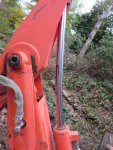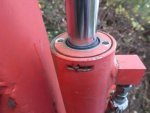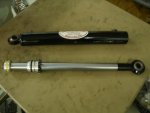So first post ... I bent the rod on the boom/crowd hydraulic cylinder. This is a BL4690 backhoe mounted on my L3710. I don't have a ton of experience with hydraulics and have a few questions.
First, I couldn't run the backhoe with the Kubota controls as most of my time has been on a Yanmar excavator. I switched hydraulic lines to change the joystick controls to the SAE layout after reading a couple posts (dipper swapped with lift). Because of how tight things are and not knowing any different, I pulled only the very end of the lines off and didn't move the inner fittings or restrictors. Did I screw something up by not moving everything? From the manual, it now looks like the dipper has a restrictor on the upper hose while the lift has the same restrictor on the lower hose.
Second, after researching the bent rod/cylinder, it sounds like this is somewhat common with this backhoe. Possibly most commonly when you're working close in to the tractor and curl the bucket. It seems like this would be more likely when you're close in, but pushing something away with the bucket. Either way I don't want this to happen again. I read about upgrading the hydraulic cylinder. The info I found did not appear to come up with clear info for part numbers, so I've taken measurements and found this cylinder:
http://www.surpluscenter.com/Hydraulics/Hydraulic-Cylinders/Double-Acting-Hydraulic-Cylinders/2x20x1-25-DA-HYDRAULIC-CYLINDER-WOLVERINE-WWXT2020-S-9-8771-20.axd.
Any thoughts on whether this would work? Or a better option? This cylinder retracted is 1" shorter than the Kubota cylinder, but with a 1" longer stroke (correct overall length). Could I add a 1" stop to the rod to make it the correct retracted length? Other than the dimensions I took, I don't know if they are the same pressure or hydraulic fitting types.
Alternatively I could just buy another Kubota cylinder for $357, but I hate having to worry that this will happen again. A new rod and seal kit would be around $160, but I don't know how to know that the internals of the cylinder aren't messed up too.
Other thoughts to either fix this or to keep this from happening again?
Sorry for the long first post...
First, I couldn't run the backhoe with the Kubota controls as most of my time has been on a Yanmar excavator. I switched hydraulic lines to change the joystick controls to the SAE layout after reading a couple posts (dipper swapped with lift). Because of how tight things are and not knowing any different, I pulled only the very end of the lines off and didn't move the inner fittings or restrictors. Did I screw something up by not moving everything? From the manual, it now looks like the dipper has a restrictor on the upper hose while the lift has the same restrictor on the lower hose.
Second, after researching the bent rod/cylinder, it sounds like this is somewhat common with this backhoe. Possibly most commonly when you're working close in to the tractor and curl the bucket. It seems like this would be more likely when you're close in, but pushing something away with the bucket. Either way I don't want this to happen again. I read about upgrading the hydraulic cylinder. The info I found did not appear to come up with clear info for part numbers, so I've taken measurements and found this cylinder:
http://www.surpluscenter.com/Hydraulics/Hydraulic-Cylinders/Double-Acting-Hydraulic-Cylinders/2x20x1-25-DA-HYDRAULIC-CYLINDER-WOLVERINE-WWXT2020-S-9-8771-20.axd.
Any thoughts on whether this would work? Or a better option? This cylinder retracted is 1" shorter than the Kubota cylinder, but with a 1" longer stroke (correct overall length). Could I add a 1" stop to the rod to make it the correct retracted length? Other than the dimensions I took, I don't know if they are the same pressure or hydraulic fitting types.
Alternatively I could just buy another Kubota cylinder for $357, but I hate having to worry that this will happen again. A new rod and seal kit would be around $160, but I don't know how to know that the internals of the cylinder aren't messed up too.
Other thoughts to either fix this or to keep this from happening again?
Sorry for the long first post...





